Four bajillion years B.C., when marketers roamed the earth trying to extol the values of Thunk-brand clubs (“Don’t go hunting and gathering without it!”), the marketing funnel was born.
Surely, by now, in all its shapes and sizes, you are deeply familiar with the funnel, which describes the decision-making process, regardless of whether you are deciding on a breakfast cereal or a new career. This funnel looks a lot like this:
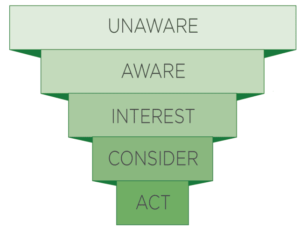
And while we threw a little 3D effect on it, it remains a very simple model.
But if you’ve noticed, the world has changed. The number of channels, tools, and ideas have exploded, starting with job boards to review sites, to social media and content, and extending into remarketing and programmatic advertising. These changes have radically changed how we hire, how we think about talent, and how we extend our employer brand (as well as how we think about what our employer brand is). They have changed how recruiters work and how talent looks for a job.
But the funnel remains, unchanging like a rerun on syndicated TV. Here it is again:
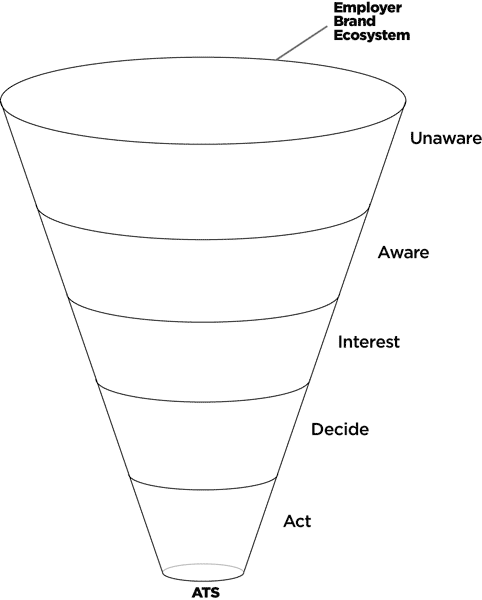
It’s not all that different. At best, the 3D effect is now more pronounced in order to more closely resemble a real funnel. We can now think about where candidates are when they are moving closer to conversion.
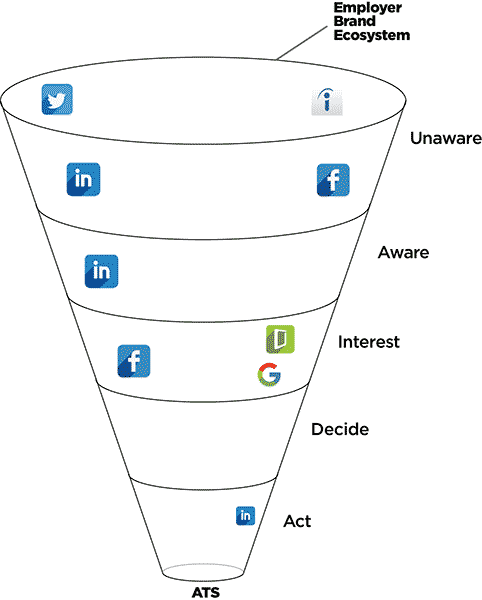 At the top, we find the ways candidates become aware of our jobs, like job boards and social media. Deeper in, candidates are looking at review sites and Google to learn more about the experience of working at that company while they try to decide if they should move forward. And at the end is the ATS, where all the magic happens.
At the top, we find the ways candidates become aware of our jobs, like job boards and social media. Deeper in, candidates are looking at review sites and Google to learn more about the experience of working at that company while they try to decide if they should move forward. And at the end is the ATS, where all the magic happens.
But this funnel remains incomplete. It is focused exclusively on third-party sites and is missing our own career site. So let’s add it in.
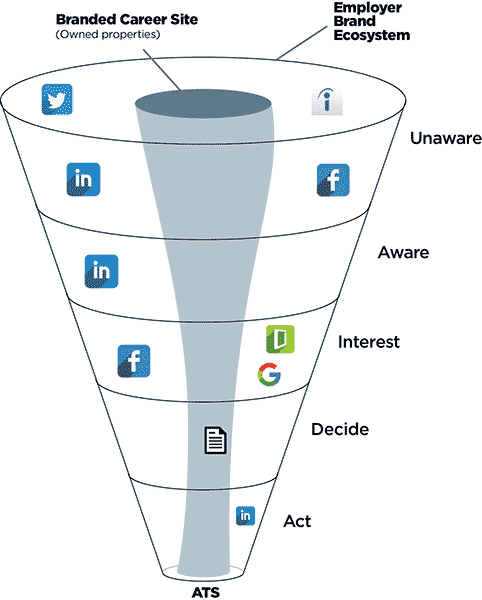
The blue section is your career site. It plays a huge role at the top of the career funnel, as it is the source of job board placements, and it is likely what all your social media and SEO strategies are pointing to. Further down, it can help showcase more locations and jobs available within your brand. Deeper still, it holds content that can compel people to act. And towards the bottom, you have the almighty “apply” button, driving people to your ATS.
There’s something important worth noting. At no stage in the funnel is your career site the only element in your funnel. Even at the bottom, where you might think your ATS rules supreme, there is space for sites like LinkedIn or Glassdoor, who can let prospects apply directly without ever leaving their sites.
This isn’t to discount the value a great career site brings to driving awareness and candidates, but we need to see the career site as part of a much larger ecosystem. It’s very common to think about the career site as the sole or primary platform in play here. But as more sites like Glassdoor, Indeed and LinkedIn show up, the more candidates are going to leverage them in the process of making a decision – and in so doing, the more likely they are to leave your site.
There’s one more thing to consider: the path. With all these properties and platforms, each serving a different value to the prospect, we have to look at how people move from one space to the other as they get closer to applying.
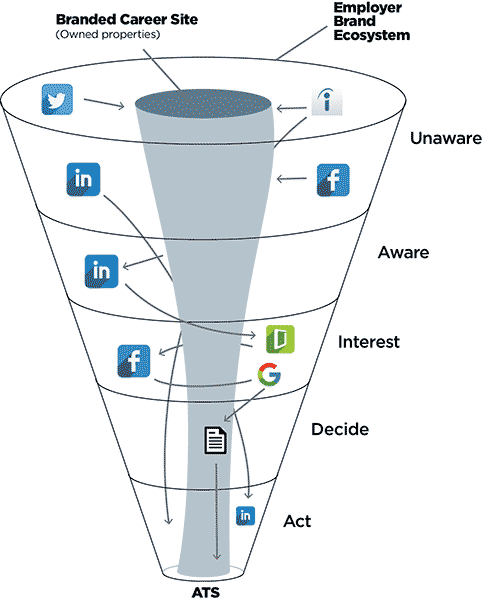
What happens after seeing a job on a job board? Some people, likely less experienced candidates looking for more entry-level jobs, will look for the apply button right away, moving down the funnel in record time. But others will start at the job board, look at the career site for more details, look to Glassdoor, LinkedIn and Google for research, and look at the career site to learn what the company cares about and how it supports its employees before finally applying. There is a dance between your site and the rest of the ecosystem.
This is both good and bad. Gone are the days when you could control the message by choosing what is published on your site. The toothpaste is out of the tube there, and there’s no putting it back in. But candidates do go to those sites. So framing and shaping the message is less a function of building content on your site, and more a function of making sure useful content is easily found on each stop of the journey.
So what does all this mean? This new funnel embraces the complex process a candidate will go through in deciding to apply and maps it out to the most common ways in which they will satisfy their curiosity. It might seem like I’m downgrading the career site, but I’m trying to put it in its proper place: as a core element that you can control, but without ignoring all the other ways candidates learn about you.
- Five Ways to Brand Yourself as a Candidate’s Employer of Choice - August 6, 2019
- Experts Weigh in on What’s to Come in 2019 - February 25, 2019
- The Importance of Employer Brand: AT&T’s Story - October 24, 2018
- Top Takeaways From #HRTechConf - September 21, 2018
- 4 Tips to Maximize Your Content Creation - July 10, 2018
- 5 Recruitment Marketing Trends You Should Know in 2018 and What to Do About Them - June 14, 2018
- 2018 Social Media Channel Statistics You Should Know - June 5, 2018
- 2018 Social Media Trends That Matter - May 14, 2018
- Pretty on Paper vs. Bottom-Line Profit: Vanity Metrics and Actionable Metrics Aren’t Equal, So What Numbers Go on the Report? - March 6, 2018
- All Aboard for Onboarding - February 21, 2018








Agree with what you write, but disagree on your geometry. Recruitment marketing (indeed, all marketing) is no longer a funnel shape. It is a loop. So, if you flatten out the funnel and twist it into a circle, you see that not long after the candidate becomes an employee, s/he gets tempted to consider other opportunities and process begins anew. This is largely due to social media – we are bombarded daily by messages from our network of friends and brands about people moving, advancing, and doing cool things. So the astute employer realizes that they must continuously re-market themselves to their current employees as well as reach out to external candidates. It may be depressing to realize that recruitment marketing is a Sisyphean task, but that’s the reality of today’s world.
[…] prospective candidates are going through this same journey when searching for a job. The good news is that you have the opportunity to make their job hunt […]